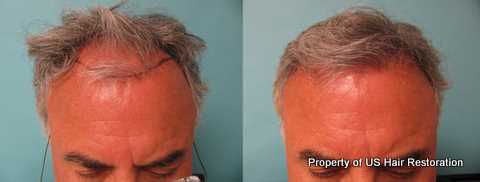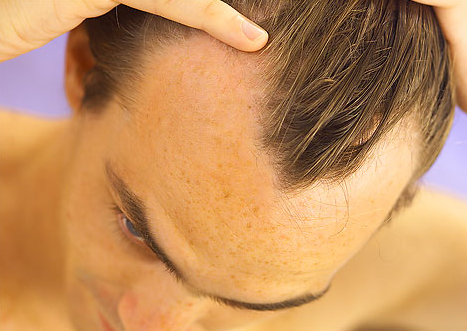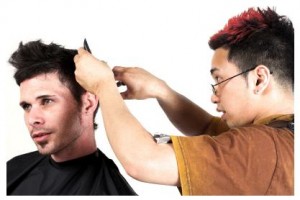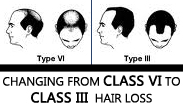Archive for the ‘hair transplant repair’ Category
Friday, February 22nd, 2013
Follicular Unit Extraction (FUE) for Scar Revision
FUE hair transplant procedure is used for completely restoring hair to balding areas of scalp. The nature of this surgery makes it more time consuming because each follicular unit (FU) is extracted singularly. The FUs can have one, two, three or even four hair shafts. This type of procedure on like ‘Strip Method’ hair transplant procedures allows for a limited number of grafts to be extracted.

Since the extraction of individual follicular units (FUs) is done individually it is perfect for the small procedure of revisioning a hair transplant scar from a previous hair transplant. The surgeon can extract a small number of grafts from the permanent zone and artistically and strategically place them in the scar. This process of using FUE uses hair to obscure and blend the margins of the scar to the surrounding scalp.
Tags: fue, hair transplant donor scar, scalp micro-pigmentation, SMP, us hair restoration
Posted in Dr. Parsa Mohebi, Hair Transplant Procedure, hair transplant repair, Los Angeles Hair Transplant | No Comments »
Friday, January 25th, 2013
SCALP Tattooing
 SMP- scalp micro pigmentation is a cosmetic hair restoration procedure where the patients scalp is tatooed with ink to create the illusion of shaved hair or hair stubble. This is a method sometimes preferred by bald men who are seeking an alternative to hair transplant surgery or to augment hair transplant surgery. Performed correctly SMP provides the appearance of short shaved hair to balding areas of the scalp. Like any cosmetic medical procedure the results are only as good as the surgeon performing the procedure. SMP- scalp micro pigmentation is a cosmetic hair restoration procedure where the patients scalp is tatooed with ink to create the illusion of shaved hair or hair stubble. This is a method sometimes preferred by bald men who are seeking an alternative to hair transplant surgery or to augment hair transplant surgery. Performed correctly SMP provides the appearance of short shaved hair to balding areas of the scalp. Like any cosmetic medical procedure the results are only as good as the surgeon performing the procedure.
SMP eliminates the hassle of frequent applications of a topical hair product to hide thinning, as they can be messy and be transferred onto clothing, sheets or pillow cases. SMP can be used for a variety of scalp conditions that include: genetic androgenic alopecia (AGA) otherwise known as male pattern balding (MPB), scarring alopecia’s from a variety of autoimmune diseases of the scalp (e.g. alopecia areata, alopecia totalis). SMP is very helpful and reducing the appearance of some types of scarring. It can also used to manage the unnatural appearance that is associated with older unnatural looking hair transplant procedures.
US Hair Restoration centers utilize SMP to reduce the appearance of scars to create an illusion of density and military shaved type hairstyles and other uses such as eyebrow density. Always make an educated decision before considering any permanent solution for hair restoration. If you are considering SMP consult with one of Los Angeles or Beverly Hills leading hair restoration centers.
Tags: Dr. Mohebi, scalp tattooing, SMP, us hair restoration
Posted in hair transplant, hair transplant repair, men hair restoration, women hair loss | No Comments »
Wednesday, April 18th, 2012
It is common for patients to wonder about the state of their receded hairline and the ability to restore it to its original place. Modern, high-quality hair restoration allows us to restore patient’s hairlines, but while always keeping the final results in mind.

When re-designing a hairline which has receded, the expectations of the patient are weighed with the reality of how the overall transplantation procedure will look with the new hairline. Not every patient has the same expectations and donor density. Some expectations are frankly unrealistic. Every individual hair restoration needs are unique to that person, and is up to the hair transplant surgeon to determine the number of grafts needed for a fuller look.
It is our desire to see all hair transplantation patients be happy with their results and we recommend always finding a quality hair loss doctor who can meet those needs. At US Hair Restoration we have several offices throughout California in Los Angeles, Beverly Hills, Orange County, San Diego, Bakersfield, and San Francisco and also provide a virtual consultation option.
Tags: receding hair lines
Posted in after hair transplant, hair transplant, hair transplant repair | No Comments »
Saturday, September 3rd, 2011
 I am often asked questions by patients after their hair restoration surgery regarding how many transplanted hair grafts will fall out and never grow back. This question comes as a result of fear based on testimonies they have heard from patients who got a hair transplant several years ago from a different surgeon, at a time when the technology available was not as dependable as it is today. Also at times, they have heard of sad stories from the tabloids of celebrity hair restorations gone wrong. I am often asked questions by patients after their hair restoration surgery regarding how many transplanted hair grafts will fall out and never grow back. This question comes as a result of fear based on testimonies they have heard from patients who got a hair transplant several years ago from a different surgeon, at a time when the technology available was not as dependable as it is today. Also at times, they have heard of sad stories from the tabloids of celebrity hair restorations gone wrong.
At US Hair Restoration we pride ourselves on patient satisfaction, quality, up-to-date precise methods, and value. We at times get patients who have had hair loss procedures gone wrong from physicians using much older methods. They come to us to correct their past surgical errors and we gain their trust by giving them results which make them happy.
The fact of the matter is over 95% of transplanted hair grafts should permanently survive based on studies administered using microscopic follicular unit transplanted methods. These studies show anywhere from 95-99% are expected take hold and grow as healthy hairs within only a few months of a transplantation surgery.
Tags: celebrity hair restorations, follicular unit transplant, hair loss procedures, hair restoration surgery, hair transplant, transplantation surgery, transplanted hair grafts, us hair restoration
Posted in after hair transplant, hair transplant, hair transplant repair | No Comments »
Thursday, August 25th, 2011
 There are times when I receive inquiries as to why professionals such as hair stylists and dermatologists do not recommend hair restoration surgery to their clients or patients. I have scratched my head to this quandary as to why this is, since hair restoration surgery is the only method which is proven, permanent, and natural! The fact is, when it is done by a skilled hair restoration surgeon, the final product looks GREAT!!! There are times when I receive inquiries as to why professionals such as hair stylists and dermatologists do not recommend hair restoration surgery to their clients or patients. I have scratched my head to this quandary as to why this is, since hair restoration surgery is the only method which is proven, permanent, and natural! The fact is, when it is done by a skilled hair restoration surgeon, the final product looks GREAT!!!
In the past twenty years, hair restoration surgery has progressed significantly, but with the most noticeable changes happening in only the past five years. The most profound breakthrough in this time is the current method of dissecting hair grafts to maximize accuracy for long-term growth as well as the ability to transplant larger quantities of hair grafts (up to 5,000 in one sitting) which is known as a giga-session.
Unfortunately many stylists, and shockingly physicians as well, are not up to speed with modern hair transplantation techniques or the positive effects a surgery can have on their clients or patients. It is our goal at US Hair Restoration to continue to educate physicians, hair stylists, and the public about the science and art of current hair transplantation techniques.
We are intentional about inviting professionals such as physicians and hair stylists to hear about our services, witness a live surgery, and see life changing results just months after an operation. This knowledge helps them to be more informed of how to better direct their clients and patients. When it comes to hair and hair loss in general, hair stylists are seen as having great credibility for making suggestions. At US Hair Restoration we have a progressive campaign for educating them called the “LA’s Top Style List” and we believe our message will be made known.
Tags: dermatologists, giga session, hair grafts, hair loss, hair restoration surgery, hair stylists, hair transplantation techniques, LA’s Top Style List, modern hair transplantation techniques, us hair restoration
Posted in hair transplant, Hair Transplant Procedure, hair transplant repair, men hair restoration | No Comments »
Thursday, June 9th, 2011
At time I receive inquiries from patients who have previously received transplant surgery at other facilities where they received a pluggy hair transplant, and are dissatisfied with their results. I recently had a patient in my San Francisco hair restoration office with a lot of pluggs from his old transplantation from years ago. He was wondering what repair transplant procedure I can do to help correct his previous surgical mishaps. I inform this patient of the repair hair transplant surgery we perform regularly.
 It is important to have a consultation with a hair transplant surgeon to see what the best method is to repair the pluggy looking area. It is important for us to make a few observations. If there is a hairline which is high enough and the donor hair numbers are sufficient, no plugs need to be removed. The hair line can be lowered and a transitional zone in front of the plugy hairline will be created with a heavier density to cover the plug visibility. It is important to have a consultation with a hair transplant surgeon to see what the best method is to repair the pluggy looking area. It is important for us to make a few observations. If there is a hairline which is high enough and the donor hair numbers are sufficient, no plugs need to be removed. The hair line can be lowered and a transitional zone in front of the plugy hairline will be created with a heavier density to cover the plug visibility.
If the hair line cannot be lowered because there is a lack of room from the original surgery, then plug removal is done by thinning them out (for denser plugs), or those micro and mini grafts could be removed. Follicular units need to be placed between the plugs giving a more even balance to the transplanted area. Adequate density is added to the transplanted area, thus minimizing the pluggy look.
I always emphasize the importance of being evaluated by a quality hair transplant surgeon, who can determine the proper route to take after a close examination. Repair in itself, appears to be simple, but there are challenging cases which might require multiple transplants for the best overall results.
Posted in after hair transplant, hair transplant, hair transplant repair, men hair restoration, San Francisco Hair Transplant | No Comments »
Tuesday, December 14th, 2010
Q:
I am a previous hair transplant patient who has class VI hair loss. I had previous procedures done to get some thin hair in the front and top. I am keeping my hair very short on the back and my primary goal was to camouflage the scar in the back of my head from previous hair transplants. So far, I have achieved this by simply growing my hair longer, and covered the rest of my scalp with Toppik-like products.

Cosmetically, the hair restoration was successful, but constant usage of this kind of product is a bit messy and annoying. Because of this, I have completely shaved my head and decided to try a different route. With the help of tattooing, I was going to go for a shaved head look. Unfortunately though, the scar is a show-stopper and I need to consider all of my options.
What I would consider to be a successful result is: short hair completely covering my head (even if only relatively light density) combined with tattooing and a self-tanner to reduce contrast. I am not “greedy” about the sides at the front, and will accept a 3 or 3A pattern. Is this possible in my case, though?
A:
It is good to hear that you are not striving for high density and that you are realistic about the final appearance of your hair. Being a class VI with limited donor hair, should leave options open to create light density in your large balding area, but obtaining more density would be extremely difficult if not impossible due to your insufficient donor hair. You should know your priorities and how many surgeries you are committed to have in order to achieve your desired look.
- If you only need to revise the scar and have trichophytic closure done to minimize the visibility of your scar, one surgery is adequate. Double edged trichophytic closure is a new technique that can improve the appearance of the scar tremendosly.
- If you are attempting to achieve higher density as well as scar revision, you may need several hair transplant procedures (depending on your donor amount available).
Your donor hair can be easily evaluated and options can be given to you for about what to be expected through attending a consultation with an experienced hair transplant doctor.
Tags: Donor Scar Hair Transplants, Donor Scar Revisions, Double Edged trichophytic Closure, FUT Hair Transplants, hair restoration, Hair Restoration Donor Scar, hair transplant donor scar, hair transplant scar revision
Posted in donor scar, hair transplant, Hair Transplant Procedure, hair transplant repair, men hair restoration | No Comments »
Tuesday, November 2nd, 2010
Dr. Mohebi is the medical director of US Hair Restoration’s hair transplant centers in Southern California. With offices centrally located amongst the major cities of Encino, Beverly Hills, Orange County, San Diego, and San Francisco, CA, Dr. Mohebi has made himself available to almost every major part of the California’s population. In addition, Dr. Mohebi is the author of Hair Restoration Blog where he responds to the questions/concerns of many aspects of hair loss and hair restoration. In addition to his blog where Dr. Mohebi answers basic questions regarding hair loss and hair restoration, the doctor has also been interviewed (for the second time) by Hair Care Beverly Hills of Buzymoms.com
Below you can see some of Dr. Mohebi’s main responses to questions posed by the interviewer.
In response to the question of whether or not clients are eligible whom have already had hair restoration and are unhappy with the results, the doctor responded: Yes, hair transplant repairs are possible and are a good portion of the hair transplant surgeries performed in our Southern California offices (mainly located in Beverly Hills, Encino,Orange County, and San Diego hair transplant consultation). Many people may have unnatural results from previous hair transplants due to the older techniques (such as plug surgery), but some may even have problems with recent hair restoration procedures due to technical issues or lack of proper judgment on the part of the hair transplant surgeon. In most situations, the repair is easy and can be done in one to two sessions.
In regards to the question of whether or not there is a minimum age requirement for hair restoration, Dr. Mohebi stated: It is not unusual for a hair transplant surgeon to discourage a person younger than 24 from pursuing a hair restoration surgery. However, nowadays microscopic techniques being used to evaluate the miniaturization of susceptible hair can assist surgeons in predicting the final pattern of hair loss. By being able to predict each patient’s final balding stages, we are able to see where the pattern of baldness is heading and based on that, we can now recommend hair transplant surgery at an earlier age.
When asked about the donor scar following a hair transplant and whether or not it will be visible, Dr. Mohebi responded: If you do not plan on shaving your hair after your hair transplant surgery, your donor wound will never be visible. However, if you plan on shaving your head for any reason, you may choose to have a FUE or Follicular Unit Extraction procedure done rather than the general FUT procedure through removing a strip from the donor area. FUE transplant eliminates the visibility of a linear scar on the back of your head and is the best option for patients who plan on shaving their head or keeping their hair very short in the future.
To determine recommended options or graft numbers for your personal case, Dr. Mohebi suggests attending an in person consultation in any of his five California regional offices. In addition, he stated: Yes, the initial consultation with me (Dr. Parsa Mohebi) is complimentary in any of our California hair transplant offices in Beverly Hills, Encino, Orange County, San Diego, and San Francisco.
Lastly, the interviewer inquired as to what clients should bring with them to their free consultations and the doctor replied: Anything related to your hair loss and hair restoration, including family history of hair loss, other medical conditions that may have been attributed to ones hair loss, medical, surgical or even cosmetic changes that you like and may help you have a better result after a hair restoration procedure.
Tags: Beverly Hills Hair Restoration, Beverly Hills hair transplant, Dr. Mohebi, Encino hair transplant, fue, Los Angeles hair transplant, San Diego hair restoration, San Francisco hair transplant, southern california hair restoration
Posted in California hair transplant, hair transplant, hair transplant repair, men hair restoration, Orange County hair transplant, San Diego hair restoration | No Comments »
Tuesday, May 11th, 2010
 Q: Q:
About 18 years ago, I underwent a hair restoration procedure with primitive technology. Nowadays, I’m very reluctant to ever do such a thing again. Since I had the transplant, I’ve been wearing a hair piece, which I don’t really like to do. I wonder: is it possible for my hair to ever look the way it did in my twenties? And, also, what if I don’t have enough donor hair, can I still get a hair transplant? If I don’t have enough donor hair, body hair is possible, right?
Also, I’m an algebra teacher, anyway this can be afforded on a salary like mine?
Sincerely,
-
A:
I appreciate the email. Here are my answers to your questions, in chronological order.
- Most of the time, it can be corrected. A lot of our patients actually have needed repair hair transplants. Their situation was very similar to yours in that they had plugs or micro-graft surgeries.
- Whether your donor hair is sufficient, I dont’t know. I have to examine you for that. A good majority of people have enough hair to cover up a hair plug procedure. Some men have so much donor hair that they can even cover up other areas of hair loss.
- It is plausible to use body hair, but it is much better to use head hair. If you’re in a situation in which you have virtually no scalp hair, and also high-quality body hair, you could be a good candidate for a body hair to head procedure.
- I can’t tell you if your hair transplant surgery will be affordable right now. Only after I evaluate you. It will all be based on the number of grafts that you require. We offer discounted rates to qualified candidates on our standby program.
- Make sure to attach photos of yourself and email them to me. The photos we need of your head are from the front, left and right sides, top and back. Make sure to also include a picture of the hair plugged areas of your head so I can take a better look at it.
After taking a look at your head shots, I’ll have a phone consultation with you and talk about the options that are open to you. It’s also a time where I can reply to all your questions.
Tags: hair plug, hair transplant repair, hair transplant through plugs, old hair transplants, plug hair implant, plug surgery, repair surgery
Posted in hair transplant, hair transplant repair | No Comments »
|
|


 SMP- scalp micro pigmentation is a cosmetic hair restoration procedure where the patients scalp is tatooed with ink to create the illusion of shaved hair or hair stubble. This is a method sometimes preferred by bald men who are seeking an alternative to hair transplant surgery or to augment hair transplant surgery. Performed correctly SMP provides the appearance of short shaved hair to balding areas of the scalp. Like any cosmetic medical procedure the results are only as good as the surgeon performing the procedure.
SMP- scalp micro pigmentation is a cosmetic hair restoration procedure where the patients scalp is tatooed with ink to create the illusion of shaved hair or hair stubble. This is a method sometimes preferred by bald men who are seeking an alternative to hair transplant surgery or to augment hair transplant surgery. Performed correctly SMP provides the appearance of short shaved hair to balding areas of the scalp. Like any cosmetic medical procedure the results are only as good as the surgeon performing the procedure. 




